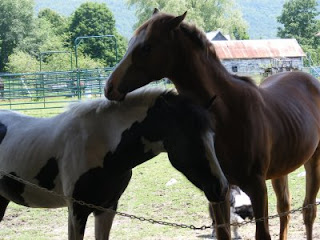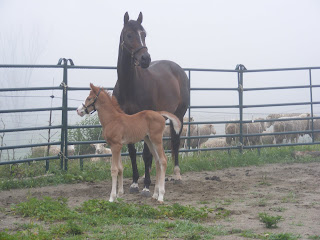So- the ponies need to stand and wait for the treat to be delivered, not go after those little fingers looking for their deserved reward.
 This first photo is a typical mugging pony. He has reached around in front of me and is headed for my hand, his ears showing his intent. Through all these photos, the lead is either dangling or thrown over his neck. I am not using the lead at all to influence his behavior. I have a body position for myself which acts as a "cue" (see the other posts about cues) to remind a pony how to behave when he smells treats. I stand next to the pony's head, facing forward and with my hands crossed at my waist. All the other horses have learned that when I stand like that, it is their job to stand quietly at my side...the "no mugging" pose leads into the "grownups are talking" exercise. If you have a horse who is actually biting hands or is otherwise being dangerous, this exercise should be started with the horse in a stall with a dutch door or stall guard so that the horse cannot actually reach you. But Stowaway just needed a little reminder lesson. So when he reached like this, I simply stood still, looked forward and only looked at him out of the corner of my eye.
This first photo is a typical mugging pony. He has reached around in front of me and is headed for my hand, his ears showing his intent. Through all these photos, the lead is either dangling or thrown over his neck. I am not using the lead at all to influence his behavior. I have a body position for myself which acts as a "cue" (see the other posts about cues) to remind a pony how to behave when he smells treats. I stand next to the pony's head, facing forward and with my hands crossed at my waist. All the other horses have learned that when I stand like that, it is their job to stand quietly at my side...the "no mugging" pose leads into the "grownups are talking" exercise. If you have a horse who is actually biting hands or is otherwise being dangerous, this exercise should be started with the horse in a stall with a dutch door or stall guard so that the horse cannot actually reach you. But Stowaway just needed a little reminder lesson. So when he reached like this, I simply stood still, looked forward and only looked at him out of the corner of my eye. 
This next photo shows the tiny baby step I was looking for as an improvement over the previous. I was not looking for him to do any more than turn his head away from me slightly. Comparing the photos, you can see the difference. With that tiny movement away from me, I clicked/treated. A movement is easier for a horse to figure out than a duration exercise anyway. So as far as Stowaway was concerned, I had clicked for him turning his head away. He is familiar enough with clicking to understand that and after I gave him his treat, he chewed it while keeping his head out of my space. It is also very important to follow the rules of good feeding. I was careful to feed him away from my body: after I clicked, I turn toward him and extend my hand toward his chest so that he is always have to rock back from me to actually receive the treat...if the treat is always found under his neck, there is less incentive to reach toward the handler for it.
 So here in this third photo, he is still flexed slightly toward me, but certainly not what I would call in my space. He is chewing his treat and waiting so I quickly click again to reward him for not reaching toward me again. Sometimes in an exercise like this it is helpful to click in fairly rapid succession so they get lots of rewards for being out of your space and aren't tempted to reach since the treats are coming regularly without that. Then you can gradually lengthen the time between clicks- 1 second, 2 seconds, 3 seconds, etc. This is where you transition to the Grownups are Talking exercise. Not only is he not allowed to mug, he is expected to stand quietly next to me and just wait patiently.
So here in this third photo, he is still flexed slightly toward me, but certainly not what I would call in my space. He is chewing his treat and waiting so I quickly click again to reward him for not reaching toward me again. Sometimes in an exercise like this it is helpful to click in fairly rapid succession so they get lots of rewards for being out of your space and aren't tempted to reach since the treats are coming regularly without that. Then you can gradually lengthen the time between clicks- 1 second, 2 seconds, 3 seconds, etc. This is where you transition to the Grownups are Talking exercise. Not only is he not allowed to mug, he is expected to stand quietly next to me and just wait patiently.And that leads us to the final photo:
 Here, Stowaway is standing quietly and just waiting for the C/T. I can count up to 10, 15, 20, etc as I lengthen this out and what he has learned is that the C/T only comes when he is waiting like this, never when he is in my space and if he waits long enough, he will be reinforced for it. Most of the horses go through a stage where they actually turn their heads away from the handler, which comes from that initial moving the head away being reinforced. You can let this happen, time your click carefully so that you click when the head is straight forward, or wait until the head comes back to a center position to click.
Here, Stowaway is standing quietly and just waiting for the C/T. I can count up to 10, 15, 20, etc as I lengthen this out and what he has learned is that the C/T only comes when he is waiting like this, never when he is in my space and if he waits long enough, he will be reinforced for it. Most of the horses go through a stage where they actually turn their heads away from the handler, which comes from that initial moving the head away being reinforced. You can let this happen, time your click carefully so that you click when the head is straight forward, or wait until the head comes back to a center position to click.Stowaway gets bonus points for standing there (he was allowed to graze) while I ran back and forth to the camera to set it on 10 second delay and then ran back to him!! :)









